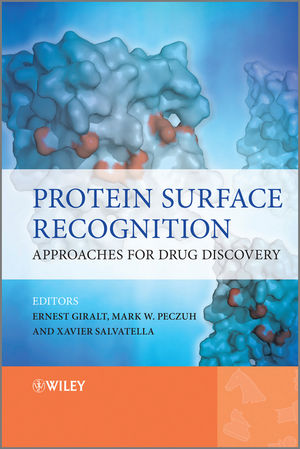Protein Surface Recognition: Approaches for Drug DiscoveryISBN: 978-0-470-05905-0
Hardcover
344 pages
December 2010
 |
||||||
List of Contributors.
PART I PRINCIPLES.
1 The Discovery and Characterization of Protein-Protein Interactions (C.W. Bertoncini, A. Higueruelo, and X. Salvatella).
1.1 Introduction.
1.2 Techniques to Identify Protein-Protein Interactions.
1.3 Techniques to Characterize Protein-Protein Interactions.
1.4 Structure and Dynamics of Protein Complexes.
1.5 Protein-Protein Complexes as Therapeutic Targets.
1.6 Conclusions.
References.
2 Biophysics of Protein-Protein Interactions (Irene Luque).
2.1 Introduction.
2.2 Intermolecular Forces in Protein Recognition.
2.3 Basic Binding Thermodynamics.
2.4 Thermodynamically Driven Drug Design.
2.5 Measurement of Binding Energetics.
2.6 Structure-based Calculation of Protein Binding Energetics.
2.7 Interfacial Water Molecules in Protein Recognition.
2.8 The Linkage Between Binding and Conformational Equilibrium in Proteins.
References.
PART II APPROACHES.
3 On the Logic of Natural Product Binding in Protein-Protein Interactivity (James J. La Clair).
3.1 Introduction.
3.2 Structural Logic.
3.3 Functional Logic.
3.4 The Need for Programmers.
3.5 Compiling the NPPI Mapper.
References.
4 Interface peptide inhibitors of PPIs (Mark W. Peczuh, and Richard T. Desmond).
4.1 Interface Peptides Defined.
4.2 Unmodified Peptides.
4.3 Modified Peptides.
4.4 Summary/Perspective.
References.
5 Inhibition of Protein-Protein Interactions by Peptide Mimics (Jorge Becerril, Johanna M. Rodriguez, Pauline N. Wyrembak, and Andrew D. Hamilton).
5.1 Introduction.
5.2 Inhibition of Calmodulin.
5.3 Inhibition of HIV-1 Fusion.
5.4 Inhibition of the Nuclear Estrogen Receptor.
5.5 Inhibition of the Bcl-xL/Bak Interaction.
5.6 Inhibition of the p53/MDM2 Interaction.
5.7 Miscellaneous Protein Targets.
5.8 Conclusion.
References.
6 Discovery of Inhibitors of Protein-Protein Interactions by Screening Chemical Libraries (Carlos García-Echeverría).
6.1 Introduction.
6.2 Screening Strategies to Identify and Develop Antagonists of Protein-Protein Interactions.
6.3 Mimetics of Common Protein Structure Motifs and Structure-based Design of Peptidomimetics.
6.4 Conclusions and Outlook.
References.
PART III TECHNIQUES.
7 High-throughput Methods of Chemical Synthesis Applied to the Preparation of Inhibitors of Protein-Protein Interactions (Annaliese K. Franz, Jared T. Shaw, and Yuchen Tang).
7.1 Introduction.
7.2 Survey of High-throughput Organic Synthesis.
7.3 Synthesis of 'Peptide-Inspired' Compounds and Libraries.
7.4 Synthesis of 'Natural Product-Inspired' Compounds and Libraries.
7.5 Diversity Oriented Synthesis (DOS) in the Discovery of PPI Inhibitors.
7.6 Summary and Outlook.
References.
8 In Silico screening (F.J. Luque, and Xavier Barril).
8.1 Introduction.
8.2 Methods for Virtual Ligand Screening.
8.3 Binding Site Characterization.
8.4 Case Studies.
8.5 Outlook and Conclusions.
References.
9.1 In Vitro Screening: Screening by Nuclear Magnetic Resonance (Ernest Giralt).
9.1.1 Saturation Transfer Difference (STD).
9.1.2 STD in Fragment-based Drug Design.
9.1.3 Chemical Shift Perturbation (CSP).
9.1.4 19F-NMR in Molecular Recognition Studies.
References.
9.2 In Vitro Screening: Methods of High-throughput Screening (Wenjiao Song and Qing Lin).
9.2.1 Introduction.
9.2.2 Statistical Evaluation of the HTS Assay Performance.
9.2.3 Biochemical Assays.
9.2.4 Cell-based Assays.
9.2.5 Conclusion.
References.
PART IV CASE STUDIES.
10 Case Study: Inhibitors of the MDM2-p53 Protein-Protein Interaction (Sanjeev Shangary, Denzil Bernard, and Shaomeng Wang).
10.1 MDM2-p53 Protein-Protein Interaction: A Case Study.
10.2 Regulation of p53 by the MDM2-p53 Protein-Protein Interaction.
10.3 Structural Basis of the MDM2-p53 Interaction.
10.4 Design of p53-based Peptides.
10.5 Design of Nonpeptidic Small-Molecule Inhibitors of the MDM2-p53 Interaction.
10.6 Challenges in the Design of Small Molecule Inhibitors of the MDM2-p53 Interaction.
10.7 Reactivation of p53 by Inhibitors of the MDM2-p53 Interaction.
10.8 Development of MDM2 Inhibitors and New Anticancer Drugs.
10.9 Concluding Remarks.
References.
11 Case Study: The Discovery of Potent LFA-1 Antagonists (Tom Gadek).
11.1 Introduction.
11.2 Structural, Molecular and Cellular Biologies of LFA-1.
11.3 The Search for Small Molecule LFA-1 Antagonists.
11.4 Screening Assays.
11.5 Lead Identification and Optimization.
11.6 Protein and Small Molecule Structure Activity Relationships (PSAR) in the LFA-1/ICAM-1 Interaction.
11.7 Summary.
References.
Index.



